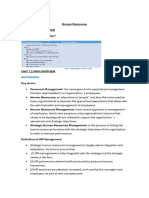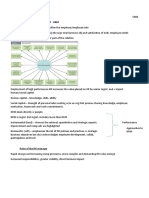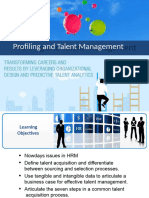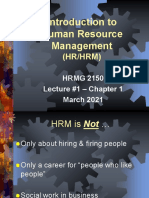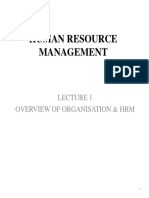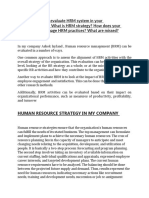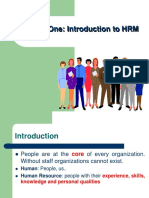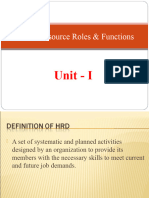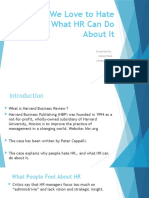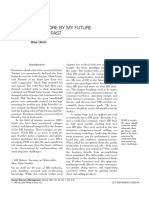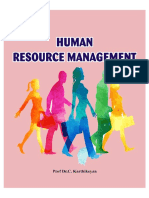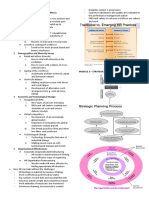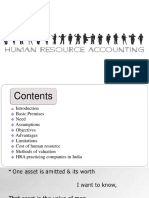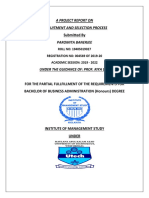HR’s stakeholders (1)
Topic 8: SHRM implementation.
Employees
Dr Hugh Bainbridge
506
Recap of last week’s lecture content
Recap: Workforce diversity and inclusion
A model based on interactivity
– The relationship between HR practices and outcomes is variable.
– It will alter depending on other third variables (contingency variables).
Types of contingency variables…
Strategy
– Cost reduction, Quality enhancement, Innovation
– Prospector, Analyser, Defender, Reactor
Organisational/Environmental factors
– Capital intensity
– R&D intensity
– Technological intensity
Employee characteristics
– Employee value and uniqueness
507
Diversity management
Recap: Definitions
Diversity
– The variety of dimensions differentiating people
Diversity management
– A strategy, or set of strategies, to create opportunities to attract the
brightest talent from the entire human resource pool and then develop
and retain that talent in order to maintain a competitive position in the
marketplace.
– Creating an inclusive environment that embraces people's differences
and provides opportunities for staff all to achieve their full potential.
508
1
� Why does diversity affect HR outcomes?
Recap: Diversity as an influence on “observers”
What is an “observer”?
– A manager, co-worker, supplier, customer, stakeholder
Processes
– Stereotypes
» Organises the information the observer has about different groups (e.g.
librarians, women, Australians) and creates generalised expectations about
new members of those groups the observer meets.
– Discrimination (a continuum)
» Overt: A clearly exercised form of unfair treatment with visible structural
outcomes
» Subtle: Negative or ambivalent treatment toward social minorities on the
basis of their minority status that is not necessarily conscious.
509
Workforce diversity
Recap: Diversity and inclusion
Positive effects of diversity
– Innovation, Empowerment, Information sharing, Group decision-
making effectiveness, Openness to dissimilarity, Productivity
But also issues to manage
– Multiple diversity dimensions
– Building a business case: Demonstrating improvements
– Managing contradictory evidence
– The breadth of design choices in diversity initiatives
– Attitudinal issues of co-workers
– Inexperience with the process
510
HR competencies
Recap: HR roles and competencies
Why are competencies important?
– Behavioural competencies
» “Applies own expert knowledge of firm’s business priorities and challenges
when identifying and delivering HR programs and services; aligns HR
offerings to highest business priorities.”
Different frameworks relating to HR competencies
– Freeman (1990)
– Noe, Hollenbeck, Gerhart, and Wright (2000)
– Ulrich and collaborators
– Society for Human Resource management (SHRM)
Fink, A. A. (2017). Why competencies are the future of HR. Society for Human Resource
Management. April 18. https://www.shrm.org/hr-today/news/hr-magazine/0517/pages/why-
competencies-are-the-future-of-hr.aspx
511
2
� HR competencies
Recap: Ulrich and collaborators (2015) – Round seven
HRCS Round seven. https://youtu.be/9BdjdgySzxE
512
Desirable attributes of a Chief HR Officer
Building an HR leadership team able to transform a business
Spencer Stuart (2024). Spencer Stuart is one of the world's leading global executive search and
leadership consulting firms, specialising in chief executive, board director and HR appointments.
https://www.spencerstuart.com/
513
Ulrich and colleagues (2017)
514
3
� Assessment 3: Recommendations report 2
Overview
Purpose
– This assignment provides an opportunity for you to demonstrate your
high level of understanding of the course materials covered so far
(especially weeks 5-8).
Topic
– Prepare an evidence-based analysis of an important problem that one
or more organisations face and a persuasive set of HR
recommendations for what should be done to address the problem
you identified.
515
Assessment 3: Recommendations report 2
Evidence for the analysis
You will support your analysis by drawing upon:
– Course concepts in the textbook/readings/lectures/tutorials
– Insights from at least two academic journal articles
– Publicly accessible organisational data / publications.
In addition, you are invited to support your analysis by
including data you personally collect (e.g., interviews,
emailed questions, surveys) from one or more of the
following people to inform the report:
– HR managers,
– Employees (future / current / former),
– Line managers, and/or
– Senior managers.
516
Assessment 3: Recommendations report 2
Structure
Section 1: Analyse the organisation’s characteristics and
environment to build a strong case for why the identified
problem(s) should be focused upon (versus alternatives) and
that clearly identifies the features of the problem that are the
most relevant to understand.
The following are simply illustrative examples of topics that
might be addressed. But you can and should consider
alternatives topics as the potential focus of your analysis:
– AI
– Demographic change
– A low growth economy
– Low productivity
– Low unemployment.
517
4
� Assessment 3: Recommendations report 2
Structure
Section 2: Based upon your Section 1 insights, provide
actionable recommendations for people who design and/or
implement HRM.
– Identify how HR skills and behaviours relevant to the issues identified in
Section 1 can be developed.
– Discuss specific improved outcomes that you would expect from these
enhanced HR skills and behaviours.
518
Assessment 3: Recommendations report 2
Formatting, Evaluation, Submission
2000 word written report
– Formatting requirements
– Submission via the Turnitin link in the Moodle course site.
519
Assessment 4
Examination
520
5
� LECTURE AGENDA
For today…
1) Competitive challenges influencing HRM
2) Who are the stakeholders of HR?
3) What is the nature of the HR-employee relationship? I.e.,
how is HR performed?
4) How is HR implemented with respect to employees?
5) How can HR enhance the value of its relationships with
employees?
521
Competitive challenges influencing HRM
a) Competing through globalisation
• Expand into foreign markets
• Manage global mobility
• Balance global and local concerns and issues
b) Competing in the knowledge economy
• Manage knowledge-intensive forms of work
• Enhance knowledge creation and knowledge sharing
c) Competing through high performance work systems Business
• Change employees’ and managers’ work roles competitiveness
• Integrate technology and social systems
d) Competing by meeting stakeholders’ needs
• Provide a return to shareholders
• Develop employees and create a positive work environment
• Address concerns of community and external stakeholders
e) Competing as an employer of choice
• Develop a strategic HRM approach to attract, retain and
motivate employees
522
Five competitive challenges
How HR practices can help companies meet them
Global Knowledge High Stakeholder Employer of
Challenge economy performance Challenge choice
challenge challenge challenge
HR Practices
• HRM strategy is matched to •Continuous learning environment is
business strategy created
• Pay systems reward skills and •Discipline system is progressive
accomplishments •Customer satisfaction and quality
• Selection system is job-related are evaluated in the performance
and legal management system
• Work attitudes of employees are •Skills and values of a diverse
monitored work force are valued and used
523
6
� HR’s stakeholders
Stakeholder analysis
Stakeholder
– Individuals and organisations that are actively involved in an
issue/project, or whose interests may be affected as a result of the
issue/project execution or issue resolution/project completion.
Types of stakeholders
– Primary stakeholders: those ultimately most affected, either positively
or negatively by an organisation's actions
– Secondary stakeholders: the "intermediaries," that is, persons or
organisations who are indirectly affected by an organisation's actions
– Tertiary stakeholders: those who will be impacted the least
Usefulness of stakeholder analysis
524
Primary Stakeholders Secondary Stakeholders
Owners, shareholders & financiers Governments and regulators
Boards of directors Media and commentators
Senior managers Civic institutions
Employees Social pressure groups
Customers Competitors
Suppliers & other business partners Consultants
Local communities Academics and researchers
Unions Trade bodies
The natural environment Environmental interest groups
Future generations Animal rights groups
Other species
525
Stakeholders
Financial
Political Owners
Community
groups
Activist
Government Groups
Suppliers HRM Customers
Consumer
Competitors Advocate
groups
Trade
associations Unions
Employees
526
7
� Competitive challenges influencing HRM
The challenge of meeting stakeholders’ needs: The
balanced scorecard
Perspective Questions answered Examples of critical indicators
Customer How do customers see Time, quality, performance,
us? service, cost
Internal What must we excel at? Processes that influence customer
satisfaction, availability of
information on service and/or
manufacturing processes
Can we continue to Improve operating efficiency,
Innovation improve and create launch new products,
and learning value? continuously improve, empower
workforce
How do we look to Profitability, growth, shareholder
Financial shareholders? value
Kaplan, R. S., & Norton, D. P. (1996). Strategic learning & the balanced scorecard. Strategy &
Leadership, 24, 5, 18-24.
527
3) Managing the connection between HRM and
relationships
a) The bi-directional link between HRM and relationships
Two distinct streams of relational HRM research
– The first considers how HR affects relationships
– A second, less popular focus, addresses how relationships affect HR
» Common concepts + method can mitigate the potential for silo formation
Approaching the relationship as fundamentally bidirectional
provides a powerful way of thinking about the connection
between HR practices and relationships
– Process theories can provide an advance by inspiring: i) more
nuanced questions, ii) the modelling of more realistic dynamic
relationships, iii) and the use of more powerful methodologies.
Bannya, A. R., Bainbridge, H. T. J., & Chan-Serafin, S. (2023). HR practices and work relationships: A
20 year review of relational HRM research. Human Resource Management, 62(4), 391–412.
528
Levels of analysis
Data collection and sample
Data source
– 16 mainstream HRM and management journals
» Academy of Management Journal, Administrative Science Quarterly, Human
Relations, Human Resource Management, Human Resource Management
Journal, International Journal of Human Resource Management, Journal of
Applied Psychology, Journal of Management, Journal of Management
Studies, Journal of Organizational Behavior, Leadership Quarterly,
Organization Science, Organization Studies, Personnel Psychology,
Personnel Review, Strategic Management Journal
Sample (2001-2020)
– Inclusion criteria
» i) Empirical studies in English, ii) Quantitative studies, iii) Contain HR and
relational variables, iv) Operationalised relationships with a human referent
– 182 articles containing 195 studies met the inclusion criteria
Bannya, A. R., Bainbridge, H. T. J., & Chan-Serafin, S. (2023). HR practices and work relationships: A
20 year review of relational HRM research. Human Resource Management, 62(4), 391–412.
529
8
�Construct Validity (Relationships) Frequency % Correlation (with
study year)
Relationship actors a 309
Employee-manager (supervisor, top, unspecified) 85 44 .05
Employee-supervisor 59 30 .10
Employee-top manager 15 8 .01
Employee-coworker 75 38 -.06
Employee-other organisational actor 41 21 -.04
Other actor-actor span organisational boundary 17 9 -.04
Other actor-actor within the organisation 17 9 -.06
Relational data (rater) a 202
Employee 148 76 .20**
Supervisors 15 8 .01
Middle managers 4 2 -.04
Top managers 5 3 .03
Unspecified managers 9 5 -.22**
Coworker 9 5 -.13†
HR representatives 11 6 -.10
Other 6 3 -.21**
Relational data (single vs multi-source) a 196
From one actor in relationship 161 83 .10
More than one but less than all actors in r/ship 3 2 -.17*
From all actors in the relationship 6 3 -.04
From one observer not in the relationship 23 12 -.01
From multiple observers not in the relationship 3 2 -.02
530
Interpersonal relationships and HRM
A stakeholder framework relevant to employees
Actors (Employees, Supervisors, HR managers, Top managers, External) have relationships with actors who are:
1. Similar in type (circular arrows. E.g., “1” Relationships among employees) and
2. Different in type (double headed arrows. E.g., “2” Employee-supervisor relationships).
Each relationship is informed by HR features (e.g., HR practice content, espoused/enacted/perceived practices)
and relationship features (e.g., quality, valence).
531
Interpersonal relationships and HRM
Employee relationships
Bannya, A. R., Bainbridge, H. T. J., & Chan-Serafin, S. (2023). HR practices and work relationships: A
20 year review of relational HRM research. Human Resource Management, 62(4), 391–412.
532
9
� Research method
Research on HRM and relationships
Concepts and methods in studying HR and relationships
– Conceptual foundations for HR’s influence on relationships (e.g., Collins
& Clark, 2003; Evans & Davis, 2005; Leana & Van Buren, 1999).
– Subsequent research (e.g., Gittell et al., 2010; Kaše et al., 2009;
Mossholder et al., 2011; Nyberg et al., 2014) and theoretical work (e.g.,
Jiang & Liu, 2015; Methot et al., 2018; Soltis et al., 2018).
– Identify distinctive concepts and methods that should underpin relational
HRM (e.g., nature of resources exchanged, types of HR practices, bi-
directional exchange processes, interdependence between actors).
533
Frequency % Correlation
Construct Validity (HR practices) (with study year)
HR practice content area a 476
Compensation and benefits 83 43 -.06
Job and work design 83 43 .21**
Training and development 86 44 .16*
Recruiting and selection 46 24 .04
Employee relations 43 22 .04
Communication 30 15 .08
Performance management and appraisal 74 38 .03
Promotions 27 14 .10
Turnover, retention and exit management 4 2 .08
HR practice variable construction 195
Single practices 107 55 -.13†
Bundles 84 43 .16*
Unclear 4 2 -.11
HR practice type a 199
Espoused 30 15 -.02
Enacted 53 27 -.27**
Perceived 116 59 .30**
534
The nature of the HR–employee relationship
Types of “employees”
Why employees?
– The HR–Outcome relationship
What do we mean by “employees”?
– Current employees
– Potential employees
– Past employees
Key principles for managing the HR-employee relationship
– Justice / Fairness
– Trust
535
10
� Current employees
In what context does HR interact with them?
– Training and development
– Performance management
– Rewards
– Occupational health and safety
– Grievance processes
Why is this group of employees important?
– Contribution to organisational functioning
536
Competitive challenges influencing HRM
The challenge of competing in the knowledge economy
Knowledge management
Knowledge workers
537
Setting the scene with respect to technology
IT, e-HRM
Technology
– The practical application of knowledge especially in a particular area
Information technology
– The application of computers and telecommunication devices to
collect, store, retrieve, and disseminate data for business purposes
e-HRM
– A system that allows managers, applicants, and employees access
to human resource related information and services through the
Internet or an organization's intranet or web portal (Lengnick-Hall &
Moritz, 2003).
Lengnick-Hall, M. L., & Moritz, S. (2003). The impact of e-HR on the human resource management
function. Journal of Labor Research, 24: 365–379.
538
11
� Technology trends relevant to HR
1. Expanded use of the Web for delivery and utilisation of HR applications
on a service basis
2. Evolution of Web-based employee and manager self-service applications
from basic data updating to sophisticated strategic applications and
workflows
3. Growth in the use of e-learning
4. Requirement for HR leaders to have command of strategic HR
technology issues
5. Heightened awareness of HR data privacy
6. Outsourcing of Human Resource Information Systems (HRIS)
7. Vendor consolidation in the HRIS industry
8. Rapid growth of employees using handheld devices with wireless e-mail
in the workplace
9. Transition to paperless pay
10. Interoperability: Greater data exchange between HRIS applications
Society for Human Resource Management. (2005). SHRM Special Expertise Panels 2005 Trends
Report. http://www.shrm.org/hrresources/whitepapers_published/misc/CMS_012889.pdf
539
Information technology and HRM
Opportunity or threat?
Effects of information technology on HR
– Employees gain complete control over their training and benefits
enrolments (self-service).
– A paperless employment office can be created.
– There is streamlining the HR department’s work.
– Technology can provide knowledge-based decision support.
– Employees and managers select the type of media they want to use
to send and receive information.
– Work can be completed at any time, any place, day or night.
– Enables closer monitoring of employees’ work.
540
e-Recruiting
Communication processes
– Static, or one-way
communication processes
» Merely provide information to
applicants about job openings
and enable them apply for jobs
online (e.g., websites, job
boards)
– Interactive technologies.
» Enhance the personalization of
e-recruiting, and increase its
overall effectiveness (e.g.,
Web 2.0, social media, virtual
reality, blogs, virtual job
previews, virtual job fairs).
Allen, D. G., Mahto, R. V., & Otondo, R. F. (2007). Web-based recruitment: effects of information,
organizational brand, and attitudes toward a Web site on applicant attraction. Journal of Applied
Psychology, 92, 16–96.
541
12
� e-Selection
e-Selection
– Use of technology to assess the degree that applicants’ knowledge,
skills, and abilities (KSAs) fit with the job requirements (e.g., web-
based job applications, tests, and interviews, Stone et al., 2013).
e-selection effectiveness and acceptance
– Job analysis
– Job applications
– Tests
– Interviews
542
AI and selection
YYY WWW
– YYY WWW
» YYY WWW
YYY WWW
– YYY WWW
» YYY WWW
YYY WWW
– YYY WWW
» YYY WWW
SHRM (2024)
543
e-Training and development
Blended learning
– Uses both online and face-to-face components to increase the
degree to which trainees feel connected with others, have richer
levels of personal communication, and control over the learning
process (e.g., Salas et al., 2005).
– 70% of employees want to bring their own mobile devices to work
(Forrester, 2012) and trainees view these technologies as more
flexible than traditional desk top computers (Gartner, 2012). Thus,
the use of new tech including virtual environments and mobile
devices may improve the effectiveness and acceptance of e-
learning methods.
Methods
– Online delivery
– Simulations
Salas, E., DeRouin, R., & Littrell, L. (2005). Research based guidelines for distance learning: What we
know so far. In H. G. Gueutal, & D. L. Stone (Eds.), The Brave New World of eHR: Human Resources
Management in the Digital Age (pp. 104–137). San Francisco: Jossey Bass.
544
13
� e-Performance Management
Performance measurement and feedback
Electronic monitoring and surveillance (EMS) practices
Holland, P., Cooper, B., & Hecker, R. (2015). Electronic monitoring and surveillance in the workplace:
The effects on trust in management, and the moderating role of occupational type. Personnel Review,
44, 1–27. www.emeraldinsight.com/0048-3486.htm
545
The future of work
Questions
Q. What will the workplace of the future look like?
Q. What are the implications of differences in employee and
HR views on these issues?
Q. Should organisations have the right to monitor employee
actions?
Q. How often should organisations monitor employee actions?
Q. What are the consequences of technologically monitoring
employees?
Q. If organisations are going to monitor employees, what is
the best way to manage this issue?
546
547
14
�548
549
550
15
�551
Key principles for HR-employee relationships
Trust
Defined in different ways but general agreement that it
requires a willingness to be vulnerable (Rousseau et al 1998)
Fragile trust / Instrumental trust / Transacting
– Based on perceptions of the immediate likelihood of rewards
» Trust may be a risk-reward r/ship that requires results of collaboration to be
sufficient and predictable.
» If one believes that a person or organisation is predictable, at least for a
single transaction, then contracting is possible if the potential rewards are
sufficient.
Resilient trust
– Can survive occasional transaction in which benefits and costs are not
equilibrated
– Such trust is not calculative but based on experience with other parties
and/or beliefs about their moral integrity
Rousseau, D., Sitkin, S., Burt, R., & Camerer, C. (1998). Not so different after all: A cross-discipline
view of trust. Academy of Management Review. 23: 393-404. https://doi.org/10.5465/amr.1998.926617
552
Key principles for HR-employee relationships
Justice / Fairness
Justice
– Individual or group perceptions of fairness in an organisation, and
reactions to such perceptions
Premise: Rational individuals choose principles of justice
– Decisions about principles are made behind a “veil of ignorance” which
blinds decision-makers to characteristics (i.e., age, wealth, position,
etc) and outcomes (which may affect their decision)
– If true, principles of justice are then presumed to be fair (unbiased)
Types of justice
– Procedural: The methods used to determine the outcomes received
– Distributive/Outcome: Perception that rewards are distributed in relation
to contribution
– Interactional/Interpersonal: Quality of interpersonal treatment in
processes
553
16
� Current employees
Perceptions of HR practices (person-job fit)
Boon, C., Den Hartog, D., Boselie, P., & Paauwe, J. (2011). The relationship between perceptions of HR
practices and employee outcomes: Examining the role of person-organisation and person-job fit. International
Journal of Human Resource Management, 22, 138-162. https://doi.org/10.1080/09585192.2011.538978
554
Current employees
Perceptions of HR practices (person-organisation/job fit)
Boon, C., Den Hartog, D., Boselie, P., & Paauwe, J. (2011). The relationship between perceptions of HR
practices and employee outcomes: Examining the role of person-organisation and person-job fit. International
Journal of Human Resource Management, 22, 138-162. https://doi.org/10.1080/09585192.2011.538978
555
Potential employees
Employer branding
In what context does HR interact with potential employees?
– Public relations / outreach
» E.g., employer of choice
– Recruitment (e.g., referrals)
– Selection
Why is this group?
– Size
» Of potential applicants
» Of non-selected applicants
556
17
� Potential employees
Employer branding
Initiatives
– Branding
(Tumasjan et
al., 2020)
– Managing
non-selected
applicants
Tumasjan, A., Kunze, F., Bruch, H., Welpe, I. M. (2020). Linking employer branding orientation and
firm performance: Testing a dual mediation route of recruitment efficiency and positive affective
climate. Human Resource Management. 59: 83-99. https://doi.org/10.1002/hrm.21980
557
Potential employees
Engaging with applicants who applied by rejected an offer
Often, a first choice applicant does not accept a job offer
– If so, it is extremely useful to know why the applicant rejected the offer
Engage promptly and constructively with applicants
– Most people are willing to share their circumstances if approached
professionally
– However, quantitative surveys have a low response rate.
– A more “relational” approach can help in improving the likelihood of a
response and in addressing concerns about confidentiality and privacy
of information.
558
Potential employees
Managing unsuccessful applicants
It is important to deal positively with unsuccessful applicants,
particularly if the Committee's first choice candidate is not
approved, or rejects the offer of appointment.
When the successful applicant has formally accepted the
offer of employment, the unsuccessful applicants are to be
advised of the outcome.
– Applicants who were not short listed, and may not previously have
been informed, should be advised in a timely manner by using the
template letter/email generated from the ANU Recruit system.
– The unsuccessful short-listed applicants should be advised of the
outcome of the process in a courteous manner.
– Chair of the Selection Committee is responsible for providing feedback.
Australian National University (2020). https://services.anu.edu.au/human-resources/recruit/managing-
unsuccessful-candidates
559
18
� Past employees
Turnover
In what context does HR interact with past employees?
– Termination processes
Why is this group important?
– Importance of referrals
– When people have a bad experience, they tell many others
Turnover
– Involuntary turnover
» Turnover initiated by the organisation (often among people who would
prefer to stay).
– Voluntary turnover
» Turnover initiated by employees.
560
Past employees
Identifying actionable data
Survey-feedback interventions
– Employee research
» Annual surveys of employee attitudes and opinions
» Exit interviews
» Exit surveys
Also information from…
– Performance management system
– Grievance systems / complaints
– Suggestion schemes
– Unions
561
Recap
Key take-aways
1. HR has different audiences/stakeholders
2. HR involves both bureaucratic and interpersonal
processes
3. HR interacts with employees at different stages of the
employee life cycle (potential, current, and past
employees)
562
19
